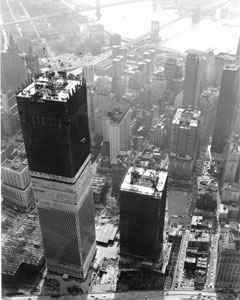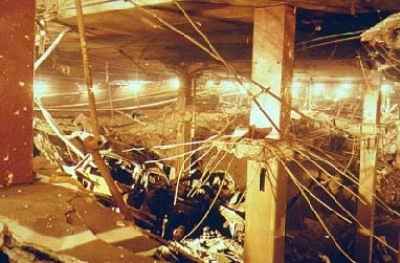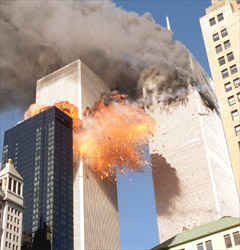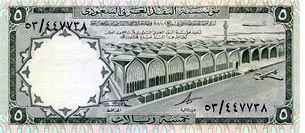|
World Trade Center Unloved, unwanted, criticized and lambasted, the World Trade Center's two towers rose out of the New York City skyline in 1972 (tower one) and 1973 (tower two). Adding a million square feet of office space, they sat primarily empty over their first ten years, artificially filled with displaced employees of the Port Authority, which had overseen the original construction. Their pinnacle as the tallest buildings in the world (1,368 and 1,362 feet) lasted less than a year before being overtaken by the Sears Building in Chicago (1,454 feet).
Unloved, unwanted, criticized and lambasted, the World Trade Center's two towers rose out of the New York City skyline in 1972 (tower one) and 1973 (tower two). Adding a million square feet of office space, they sat primarily empty over their first ten years, artificially filled with displaced employees of the Port Authority, which had overseen the original construction. Their pinnacle as the tallest buildings in the world (1,368 and 1,362 feet) lasted less than a year before being overtaken by the Sears Building in Chicago (1,454 feet).
Where the previous skyscrapers of New York (the first in the world) were bejeweled with the affectations of Art Deco and the New Modernism, the twin towers added two big fucking rectangles on the lower end of Manhattan. Architecture critics, the bane of human writing, had their own version of a field day with these two ugly behemoths rising over their neighbors. Phrases like "Lego Blocks" got bandied about, and rightly so. Man, they were ugly. They were designed by architect Minoru Yamasaki, who was said to be afraid of heights, and who therefore closed off the potentially breathtaking views with tiny little rectangles, designed (supposedly) so you could be near the windows and hold onto the wall with both your hands outstretched. Each floor of each tower was about an acre in square feet, and you could basically glance out over a sea of faceless cubicles and be unaware you were cranking away at one of the tallest man-made points on earth. Engineering issues unique to the buildings cropped up constantly during their design. The most dramatic was the issue of sway, that is, these two buildings needed to be able to flex back and forth in the high winds at that altitude. On a good windy day, the towers could sway back and forth about three feet. It wasn't known how much motion human beings could take before they'd start to feel ill, so a secret experiment was carried out in a distant state (far away from where the New York press would hear about it) where unknowing applicants would be called to what they thought was a research experiment filling out forms. In fact, they were entering what was actually a small room outfitted with hydraulics, which would move the entire room back and forth slowly, not unlike the sway that would be on the top floors of the proposed towers. It was found, to the dismay of the experimenters, that human beings could detect tiny amounts of sway. A number of additional design changes were put in to counterract this motion, so that it was ultimately minimized. But "minimized" is not the same as "removed", and it could be pretty terrifying to be on the top of the towers on windy days (pencils could roll off desks, for example).
Then there was the sticky issue of elevators. The mass of the towers broke the paradigm of how elevators were normally installed in buildings, with a bank of them allowing you to go to any other floor. Instead, the idea of sky lobbies had to be created, so that all the elevators would stop at an arbitrary floors in the middle of the towers (the 44th and 78th), and then allow you to access the upper floors. An awful lot of work for a pair of buildings that were never supposed to be more than 80 stories; the original plan for the open plaza in the world trade center was to provide ten million square feet of office space (which wasn't all that needed) in that smaller amount of floors, but the public relations department of the Port Authority thought it better to build not just towers, but the tallest towers ever. And if the PR department is making your engineering decisions, you know you're screwed. But all these nattering nabobs of negativity have been forgotten, pushed away into ancient history as the towers themselves have been; in a pair of attacks we will refer to as the really annoying one and the really scary one, the towers were damaged and ultimately destroyed. The really annoying one occurred on February 26, 1993, when a rented Ryder truck holding a homemade fertilizer bomb and cyanide gas exploded in the parking garage of the WTC. Six people died. The really scary one occurred on September 11, 2001, when two American Airlines planes were crashed into the towers within an hour of each other, causing both towers to collapse. About 3,000 people died.
The Annoying One The 1993 World Trade Center attack was, it is generally held, an attempt to make one of the towers fall over onto the other, collapsing both, and then sending a huge plume of cyanide gas into New York City. Assuming every single planned aspect of the attack had followed through, tens of thousands would have died. This would have been an unforgettable holocaust across the city as the towers toppled onto whatever lay in the direction they fell.
The 1993 World Trade Center attack was, it is generally held, an attempt to make one of the towers fall over onto the other, collapsing both, and then sending a huge plume of cyanide gas into New York City. Assuming every single planned aspect of the attack had followed through, tens of thousands would have died. This would have been an unforgettable holocaust across the city as the towers toppled onto whatever lay in the direction they fell.
It didn't quite work out that way, and in fact the general rule that terrorist cells tend to be quasi-fuckups at operations held true once more. The truck that lay against a wall in the parking garage was entirely too weak to do the job, and just succeeded in blowing a big hole beneath it. The cyanide gas, instead of blowing across the city in a fearsome tidal wave of death, instead was obliterated in the heat of the explosion. In all, a half-dozen were dead, and while everyone was shocked and dismayed, it seemed quite provincial in its scope: no dead children to grab the hearts of Americans (as occurred in the later Oklahoma City bombing), just some fuckery in downtown Manhattan. The explosion didn't even obliterate the van that the explosives and gas were stored in; the massive army of inspectors, investigators and cops that overran the parking garage found pieces of it within days. As luck had it, the vehicle identification number (VIN) of the van was etched into one of the pieces. The feds talked to the Ryder rental agency that the van came from, and they indicated that the owners had reported the van stolen. And then came the phone call. Yes, that's right, the geniuses behind the attack had called to ask for the deposit on the van back. Busted! So began the finger-pointing, research, and momentary interest in Middle East politics as regarding America. Suspects were rounded up, ringleaders hoisted before the courts, and trials begun. Americans and news agencies were faced with the daunting task of trying to pronounce and remember Arabic names like Mahmud Abouhalima, Ramzi Yousef, Nidal Ayyad, and Amad Mohammad Ajaj. Arabic countries have never been American Intelligence's strong suit (to the public eye, anyway), and the stumbling over of names and places in news organizations became comedic. Another effect was to turn on anyone who even sounded a little bit Muslim, Arabic, or swarthy, a tradition that has continued to the present day. It should be noted that this was hardly the first terrorist attack on US soil or against US interests. Bombings would occur with the US Embassies in Kenya and Tanzania, a Hard Rock Cafe in South Africa, and others. But as pretty much everyone on the planet knows at this point, that wasn't the end of the story for the twin towers: that came eight years later. The Scary One Here's a recipe for getting attention: take two jet-fuel loaded, nearly empty aircraft, two of the largest towers in the world, a few guys who can sort of fly a plane, and some thugs who can keep some early-morning air travellers scared shitless for about 40 minutes. Mix well.
Here's a recipe for getting attention: take two jet-fuel loaded, nearly empty aircraft, two of the largest towers in the world, a few guys who can sort of fly a plane, and some thugs who can keep some early-morning air travellers scared shitless for about 40 minutes. Mix well.
The whole process was a complete sucker punch: nothing fucks up most security procedures than someone who gets into a secure area planning never to come out of it again. It works for suicide bombers and it works for people who intend to crash a plane. Setting aside the hundred conspiracy theories that have risen out of the ashes like so much flatulence, the currently accepted story is this: 20 hijackers, some of which were trained as some level of airplane pilot, took control of four American Airlines flights during the morning of September 11, 2001. Based on phone calls from the planes made during the hijacking by the hostages, stewardesses were stabbed or killed with concealed box cutters wielded by the "muscle", which lured the pilots of the planes out of their cockpit. The trained pilots then took control of the planes and proceeded to aim them at various targets, including the Pentagon, another unknown target in Washington DC, and both of the twin towers. One of these flights was likely averted by passengers rising up against their captors, causing the plane to crash harmlessly (except for the passengers) in a field. The others hit their targets straight on. While the Pentagon could be considered a military target, and within the bounds of warfare, the twin towers were anything but. A common terrorist technique is to utilize two or more explosives; a minor charge that brings in emergency service personnel and civilians in close to see the resultant damage, and then a whopper that kills as many people as possible. Such was the case with the towers, where the first plane that took a direct flight into the top floors caused a panic, as everyone thought it an accident, only to have a second plane directly veer into it. There have been dozens, perhaps hundreds of what could be considered large-scale terrorist acts on the Earth in human history, but this was by far the most drastic loss of life in recent memory. And we caught it on video; unlike a lot of other horrible events, hundreds of cameras aimed at the World Trade Center when one plane smashed into it caught, with unbelievable clarity, the second one. In this manner, the World Trade Center attack was perfect by terrorist standards. It was breathtaking, it struck fear and terror into surrounding areas (and in fact, the world), and it was about as highly public as you could get. It also wiped away, at the same horrifying moment, any thought that the first crash had been accidental or unintentional. And then, the towers collapsed, which nobody had expected. Later engineering analysis says that it was not the impact of the planes, but the loosing of thousands of gallons of burning jet fuel that weakened the structure enough to cause the weight of the upper floors to drive down the lower floors. How much force was involved? Girders were vaporized in the process. The entire event, from "Hey, what's with that plane?" to the second tower collapse was about two hours. And while 3,000 dead may seem a complete and total disaster, the fact is that fifty thousand people worked in the towers and another twenty thousand would visit the top floor observation area daily. It is a tribute to how well built the towers were that they stood long enough to evacuate tens of thousands of inhabitants before collapsing.
What's the Deal
What isn't entirely clear is why the Twin Towers pissed off terrorists enough to not only try to destroy them, but come back for a second try. It certainly wasn't because of the Architect himself: Yamasaki also designed Dhahran Air Terminal, a building that so enamored the Saudi Royal Family that it graces their currency. While there is no actual evidence to this effect, Osama bin Laden may have been personally offended by the Towers' architecture. Consciously or subconsciously, Yamasaki modeled the WTC square layout after Mecca, and incorporated pseudo-Islamic arches at the base of the buildings. The sides of the buildings are an intricate pattern reminiscent of the Moors. Yet the buildings still appear distinctively American and Godless. Not only may have bin Laden and his ilk hated what the buildings stood for, he may have hated them for their perversion of Islamic culture.
AftermathThere's a really big hole in the ground where the towers used to stand, and the New York skyline lacks their two dreary fingers poking up into the sky. Reports of people seeing the towers came for months afterwards (a natural defense mechanism), as did the realization that some mighty nasty shit got let out into the atmosphere around New York City. Authorities and experts had been quick to claim there would be no long-term health effects after the cloud of dust and particles settled on the city, but this is not likely to turn out to be true.The pinball machine of America is completely screwed up and buzzing TILT at this point, as we've gone completely over the top trying to prevent anything this horrible happening on US soil in the future. How successful this goulash of crackdown, paranoia, and jingoism will be is something only time can tell. An awful lot of people are dead, and we'll miss them very much, but there's likely to be a lot of other things we're going to miss as well, like the fourth amendment. In a world where Alan Dershowitz called for the approval of torture as an information gathering tool, and where radio stations pulled John Lennon's "Imagine" off the air, who knows where it'll all lead. Some day we'll look back on all this and laugh... but not today, and not next week. As the city rebuilds the World Trade Center, a couple things are obvious. First, it is highly unlikely we will ever see two towers rise in that location again. Second, whatever does get built there will be resoundingly hated, because that's how people react to anything new. And finally, we can at least take heart that nothing built on that spot could ever, even on purpose, be as ugly as what was there before. |
 The buildings were built on top of old landfill, which had been created over time to extend Manhattan out onto the Hudson River. Since you really can't build something this large on landfill, the construction crews had to drill down 70 feet into bedrock, then build a huge steel cage around the edges before excavating the hole of dirt. Without this little addition, the parking lot and shopping center underneath the World Trade Center would have immediately filled with water. The million cubic yards of dirt from this operation were eventually used to create Battery Park City.
The buildings were built on top of old landfill, which had been created over time to extend Manhattan out onto the Hudson River. Since you really can't build something this large on landfill, the construction crews had to drill down 70 feet into bedrock, then build a huge steel cage around the edges before excavating the hole of dirt. Without this little addition, the parking lot and shopping center underneath the World Trade Center would have immediately filled with water. The million cubic yards of dirt from this operation were eventually used to create Battery Park City.